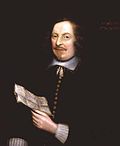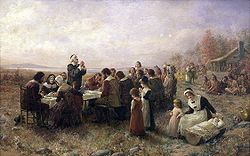Plymouth Colony
Plymouth Colony was an English colony in North America. It existed from 1620 to 1691. At its height, Plymouth Colony occupied most of the southeastern part of the modern state of Massachusetts.
Plymouth Colony | |||||||||||
|---|---|---|---|---|---|---|---|---|---|---|---|
| 1620–1686 1689–1691 | |||||||||||
 Plymouth Colony town locations | |||||||||||
| Status | Colony of England | ||||||||||
| Capital | Plymouth 41°50′42″N 70°44′19″W / 41.8450°N 70.7387°WCoordinates: 41°50′42″N 70°44′19″W / 41.8450°N 70.7387°W | ||||||||||
| Common languages | English | ||||||||||
| Religion | Puritanism | ||||||||||
| Government | Self-governing colony | ||||||||||
| Governor | |||||||||||
• 1620–1621 | John Carver (first) | ||||||||||
• 1689–1692 | Thomas Hinckley (last) | ||||||||||
| Legislature | General Court | ||||||||||
| Historical era | British colonization of the Americas Puritan migration to New England (1620–1640) | ||||||||||
• | 1620 | ||||||||||
| 1621 | |||||||||||
| 1636–1638 | |||||||||||
• New England Confederation formed | 1643 | ||||||||||
| 1675–1676 | |||||||||||
• | 1686 1689–1691 | ||||||||||
| |||||||||||
History
The first settlement of the Plymouth Colony was at New Plymouth. This settlement served as the capital of the colony. It is today the modern town of Plymouth, Massachusetts.
Separatists and Anglicans (together, the "Pilgrims") founded the colony. With Jamestown and other settlements in Virginia Colony, it was one of the earliest successful English colonies in North America. It was the first sizable permanent English settlement in the New England region.
The colony made a treaty with Chief Massasoit. This helped to make the colony a success. The colonists played a role in King Philip's War. The colony merged with the Massachusetts Bay Colony and other territories in 1691. Together they formed the Province of Massachusetts Bay.
Plymouth holds a special role in American history. Many of the Plymouth colonists left England for a place to worship in their own way. The social and legal systems of the colony became tied to their religious beliefs, as well as English custom. Many of the people and events surrounding Plymouth Colony have become part of American folklore. These include Thanksgiving and Plymouth Rock.
Plymouth Colony Media
Edward Winslow negotiated the treaty with the Wampanoags, served as the Pilgrims' ambassador to their financial backers in England, and was as one of the first governors of Plymouth Colony. This portrait is the only portrait of a Pilgrim that was painted from life.
The village of Scrooby, England, c. 1911, home of the Mayflower Pilgrims until 1607
Embarkation of the Pilgrims, an 1844 portrait by Robert Walter Weir, which now hangs in the United States Capitol rotunda
The cover of John Smith's A Description of New England, published in 1616, which was the first text to use the name "New Plymouth" to describe the site of the future colony
"Signing of the Mayflower Compact" by Edward Percy Moran, c. 1900
The Landing of the Pilgrims, an 1877 portrait by Henry Bacon
The First Thanksgiving at Plymouth, a 1914 portrait by Jennie Augusta Brownscombe that is now housed in Pilgrim Hall Museum in Plymouth, Massachusetts
Thanksgiving at Plymouth, a portrait by Jennie Augusta Brownscombe now housed in the National Museum of Women in the Arts in Washington, D.C.
John Robinson's memorial outside of St. Peter's Church in Leiden
Related pages
References
- Addison, Albert Christopher (1911). The Romantic Story of the Mayflower Pilgrims. The Plymouth Colony Archive Project. Retrieved 2007-04-30.
Other websites
- Timeline of Plymouth Colony Archived 2007-04-26 at the Wayback Machine
- Colonial America:Plymouth Colony 1620 A short history of Plymouth Colony hosted at U-S-History.com, includes a map of all of the New England colonies.
- The Plymouth Colony Archive Project a collection of primary sources documents and secondary source analysis related to Plymouth Colony.
- Pilgrim ships from 1602 to 1638 Pilgrim ships searchable by ship name, sailing date and passengers.








